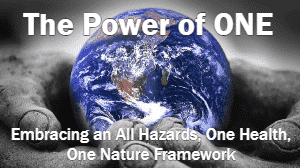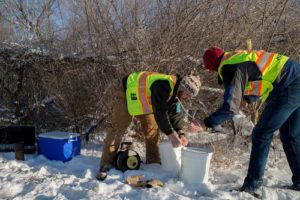The Power of One
“Fight for the things that you care about, but do it in a way that will lead others to join you.”
- Ruth Bader Ginsburg -
“We can change the world and make it a better place. It is in our hands to make a difference.”
- Nelson Mandela -
 By embracing the One Health, One Nature concept, we acknowledge and appreciate the interconnectedness of all creatures and all habitats. The well-being of every animal, plant, and person depends upon the unified health of the natural world. Hazards that threaten or impact the One Nature will be determinants of the One Health. In this article, we will reflect on our recent series dedicated to the many adverse effects of PFAS (per- and poly-fluoroalkyl substances) as a vivid example of the One Health, One Nature model and how this leads to the next steps of All Hazards, One Framework.
By embracing the One Health, One Nature concept, we acknowledge and appreciate the interconnectedness of all creatures and all habitats. The well-being of every animal, plant, and person depends upon the unified health of the natural world. Hazards that threaten or impact the One Nature will be determinants of the One Health. In this article, we will reflect on our recent series dedicated to the many adverse effects of PFAS (per- and poly-fluoroalkyl substances) as a vivid example of the One Health, One Nature model and how this leads to the next steps of All Hazards, One Framework.
Industries and manufacturers have used synthetic chemicals known as PFAS since the 1940s. These durable and chemically resistant substances are incorporated into countless products to create smooth surfaces, resist stains, repel water, and withstand fire. Unfortunately, the exact property that makes these chemicals so popular is also what has made PFAS so problematic. These substances do not break down easily or spontaneously, needing more than 1,000 years to degrade by just one-half. And not only does PFAS remains intact generation after generation, these toxins continually accumulate in our shared One Nature - in the air, water, soil, plants, animals, and our bodies.
Understanding and valuing the planet as One Nature allows us to realize both the positive and negative consequences of our interactions with every aspect of our environment. With respect to PFAS, these interactions have critically harmful effects. The continual assault by PFAS toxins in our air, water, soil, and food supplies is having dire consequences. Every living thing is suffering organ damage, procreation dysfunction, and many other health problems. For as we are of One Nature, so too are we of One Health. But how do we begin to tackle these threats to ourselves and our planet?
When considering individual hazards and threats, a first instinct may be to have a separate plan for each situation that you can envision. Typically, such plans involve actions that are different from our everyday activities and may be difficult to coordinate or even remember in the midst of a crisis or urgent situation. However, disaster response history has taught us a different approach. Regardless of the specific risk or threat, having the response follow a common pathway allows us to learn what to expect and does not require new skill sets every time. We can learn and trust that every hazard will be addressed in a goal-oriented manner, with assessments and actions needed to achieve the desired outcome. That is the essence - and the strength - of the All Hazards, One Framework approach. So, then, how can we use this process to save our shared One Nature, One Health from the effects of pollutants like PFAS?
 To address the many issues related to PFAS contamination, the All Hazards, One Framework approach coaches us first to set the goals for response, recovery, and resilience. With these goals in mind, the problem’s assessment is done next, followed by the actions required to achieve the desired outcome. As detailed in prior articles, the scope of the PFAS problem has been evaluated extensively and found to be vast, with devastating effects for the entire planet. Eliminating new sources and removing existing sources would be necessary to combat any hazard and certainly applies to PFAS remediation. Due to the characteristics of PFAS, these actions will need to occur in tandem if any real progress is to be made in our lifetime. Furthermore, remediation and elimination of PFAS from all links in the food chain will require collaboration and action on the part of individuals, communities, leadership, and many other stakeholders. Each of us holds the power of using or purchasing PFAS-free goods, advocating for the removal of PFAS from our environment, and supporting organizations and leadership who support One Health, One Nature above self-interest.
To address the many issues related to PFAS contamination, the All Hazards, One Framework approach coaches us first to set the goals for response, recovery, and resilience. With these goals in mind, the problem’s assessment is done next, followed by the actions required to achieve the desired outcome. As detailed in prior articles, the scope of the PFAS problem has been evaluated extensively and found to be vast, with devastating effects for the entire planet. Eliminating new sources and removing existing sources would be necessary to combat any hazard and certainly applies to PFAS remediation. Due to the characteristics of PFAS, these actions will need to occur in tandem if any real progress is to be made in our lifetime. Furthermore, remediation and elimination of PFAS from all links in the food chain will require collaboration and action on the part of individuals, communities, leadership, and many other stakeholders. Each of us holds the power of using or purchasing PFAS-free goods, advocating for the removal of PFAS from our environment, and supporting organizations and leadership who support One Health, One Nature above self-interest.
One Heath, One Nature teaches us that we are integral to an Incredibly diverse planetary ecosystem of interdependent parts. The ability to influence positive change lives in each of us. To safeguard each component of this ecosystem, we will need to face and overcome All Hazards, both natural and man-made. Shared dedication and involvement of every individual, family, community, organization, and industry can be unified through One Framework approaches and enable us to meet these challenges. There is strength in our collective efforts to sustain positive change. These are the strengths - and the responsibilities - of One.
About the Author:

Allison A. Sakara, NP, MSN, RN, PHRN, is a nurse practitioner with decades of experience in pediatrics, hematology/oncology, and disaster response. Allison is the Co-Founder & Executive Director of the High Alert Institute, a 501c3 not-for-profit educational public charity dedicated to providing disaster readiness education and resources to unserved and underserved communities, industries, and charitable organizations in an All Hazards, One Health, One Nature, One Framework paradigm. Learn more about the High Alert Institute at www.HighAlertInstitute.org
You can also learn about PFAS remediation and replacement education from our partner, Five Bugles Institute, at www.fivebuglesinstitute.com/pfas
Two reputable organizations maintaining lists of PFAS-free products, retailers, and packaging policies are listed below:
- Clean Production Action (https://www.cleanproduction.org/resources/entry/pfas) – listings of food packaging, food production, and food service items verified to be PFAS-free
- PFAS Central (https://pfascentral.org/pfas-free-products/) – listings of brands, products, retailers, and manufacturers that are verified PFAS-fee

